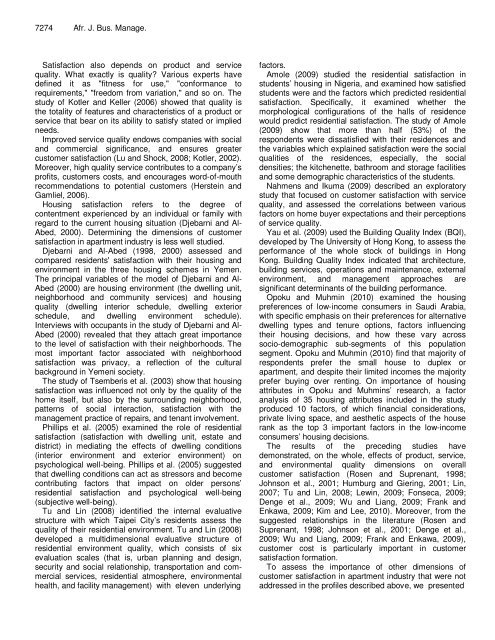Download Complete Issue (8760kb) - Academic Journals
Download Complete Issue (8760kb) - Academic Journals
Download Complete Issue (8760kb) - Academic Journals
You also want an ePaper? Increase the reach of your titles
YUMPU automatically turns print PDFs into web optimized ePapers that Google loves.
7274 Afr. J. Bus. Manage.<br />
Satisfaction also depends on product and service<br />
quality. What exactly is quality? Various experts have<br />
defined it as "fitness for use," "conformance to<br />
requirements," "freedom from variation," and so on. The<br />
study of Kotler and Keller (2006) showed that quality is<br />
the totality of features and characteristics of a product or<br />
service that bear on its ability to satisfy stated or implied<br />
needs.<br />
Improved service quality endows companies with social<br />
and commercial significance, and ensures greater<br />
customer satisfaction (Lu and Shock, 2008; Kotler, 2002).<br />
Moreover, high quality service contributes to a company’s<br />
profits, customers costs, and encourages word-of-mouth<br />
recommendations to potential customers (Herstein and<br />
Gamliel, 2006).<br />
Housing satisfaction refers to the degree of<br />
contentment experienced by an individual or family with<br />
regard to the current housing situation (Djebarni and Al-<br />
Abed, 2000). Determining the dimensions of customer<br />
satisfaction in apartment industry is less well studied.<br />
Djebarni and Al-Abed (1998, 2000) assessed and<br />
compared residents' satisfaction with their housing and<br />
environment in the three housing schemes in Yemen.<br />
The principal variables of the model of Djebarni and Al-<br />
Abed (2000) are housing environment (the dwelling unit,<br />
neighborhood and community services) and housing<br />
quality (dwelling interior schedule, dwelling exterior<br />
schedule, and dwelling environment schedule).<br />
Interviews with occupants in the study of Djebarni and Al-<br />
Abed (2000) revealed that they attach great importance<br />
to the level of satisfaction with their neighborhoods. The<br />
most important factor associated with neighborhood<br />
satisfaction was privacy, a reflection of the cultural<br />
background in Yemeni society.<br />
The study of Tsemberis et al. (2003) show that housing<br />
satisfaction was influenced not only by the quality of the<br />
home itself, but also by the surrounding neighborhood,<br />
patterns of social interaction, satisfaction with the<br />
management practice of repairs, and tenant involvement.<br />
Phillips et al. (2005) examined the role of residential<br />
satisfaction (satisfaction with dwelling unit, estate and<br />
district) in mediating the effects of dwelling conditions<br />
(interior environment and exterior environment) on<br />
psychological well-being. Phillips et al. (2005) suggested<br />
that dwelling conditions can act as stressors and become<br />
contributing factors that impact on older persons’<br />
residential satisfaction and psychological well-being<br />
(subjective well-being).<br />
Tu and Lin (2008) identified the internal evaluative<br />
structure with which Taipei City’s residents assess the<br />
quality of their residential environment. Tu and Lin (2008)<br />
developed a multidimensional evaluative structure of<br />
residential environment quality, which consists of six<br />
evaluation scales (that is, urban planning and design,<br />
security and social relationship, transportation and commercial<br />
services, residential atmosphere, environmental<br />
health, and facility management) with eleven underlying<br />
factors.<br />
Amole (2009) studied the residential satisfaction in<br />
students’ housing in Nigeria, and examined how satisfied<br />
students were and the factors which predicted residential<br />
satisfaction. Specifically, it examined whether the<br />
morphological configurations of the halls of residence<br />
would predict residential satisfaction. The study of Amole<br />
(2009) show that more than half (53%) of the<br />
respondents were dissatisfied with their residences and<br />
the variables which explained satisfaction were the social<br />
qualities of the residences, especially, the social<br />
densities; the kitchenette, bathroom and storage facilities<br />
and some demographic characteristics of the students.<br />
Nahmens and Ikuma (2009) described an exploratory<br />
study that focused on customer satisfaction with service<br />
quality, and assessed the correlations between various<br />
factors on home buyer expectations and their perceptions<br />
of service quality.<br />
Yau et al. (2009) used the Building Quality Index (BQI),<br />
developed by The University of Hong Kong, to assess the<br />
performance of the whole stock of buildings in Hong<br />
Kong. Building Quality Index indicated that architecture,<br />
building services, operations and maintenance, external<br />
environment, and management approaches are<br />
significant determinants of the building performance.<br />
Opoku and Muhmin (2010) examined the housing<br />
preferences of low-income consumers in Saudi Arabia,<br />
with specific emphasis on their preferences for alternative<br />
dwelling types and tenure options, factors influencing<br />
their housing decisions, and how these vary across<br />
socio-demographic sub-segments of this population<br />
segment. Opoku and Muhmin (2010) find that majority of<br />
respondents prefer the small house to duplex or<br />
apartment, and despite their limited incomes the majority<br />
prefer buying over renting. On importance of housing<br />
attributes in Opoku and Muhmins’ research, a factor<br />
analysis of 35 housing attributes included in the study<br />
produced 10 factors, of which financial considerations,<br />
private living space, and aesthetic aspects of the house<br />
rank as the top 3 important factors in the low-income<br />
consumers’ housing decisions.<br />
The results of the preceding studies have<br />
demonstrated, on the whole, effects of product, service,<br />
and environmental quality dimensions on overall<br />
customer satisfaction (Rosen and Suprenant, 1998;<br />
Johnson et al., 2001; Humburg and Giering, 2001; Lin,<br />
2007; Tu and Lin, 2008; Lewin, 2009; Fonseca, 2009;<br />
Denge et al., 2009; Wu and Liang, 2009; Frank and<br />
Enkawa, 2009; Kim and Lee, 2010). Moreover, from the<br />
suggested relationships in the literature (Rosen and<br />
Suprenant, 1998; Johnson et al., 2001; Denge et al.,<br />
2009; Wu and Liang, 2009; Frank and Enkawa, 2009),<br />
customer cost is particularly important in customer<br />
satisfaction formation.<br />
To assess the importance of other dimensions of<br />
customer satisfaction in apartment industry that were not<br />
addressed in the profiles described above, we presented

















